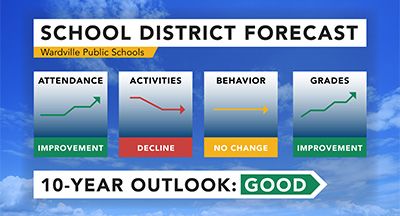The Golden Minute: Reduce Dropout Rates in One Easy Step
#Achievement
Leah Kruger
by
Leah Kruger

|
Leah Kruger Communications Advocate |

|

|

|
 |
How did they come to this conclusion and how should that one extra minute be spent? Give us a couple of minutes and we’ll provide you with answers to those questions and tell you how your district can successfully integrate the study’s findings into your own weekly schedule.
The Backstory
All students in any given school have access to the same resources and instruction between the opening bell and dismissal. Therefore, the variables that influence their success rates must come, at least in part, from beyond school walls. So what is the largest external influencer? Researchers determined it is often the students’ parents.They noticed something troubling, however, or rather an opportunity for immense improvement. Though parents and teachers play invaluable, complementing roles in the academic lives of students, communication between the two is often nonexistent, or limited at best. For example:
- 40% of families with school-age children in the U.S. report receiving a phone call specifically about their child from a school administrator or teacher in the previous year.
- 66% of high school parents do not agree that teachers keep them informed about classroom activities, events, and requirements.
- Fewer than 25% of parents can name a basic milestone that their child should have learned in school over the previous year.
The grade is in and it isn't good. Our education system is suffering from a communication breakdown.
The Study
In an attempt to bridge the gap, researchers dove into an in-depth study on an easy, effective way to restore parent-teacher communication. They divided 435 students and their families into three categories. Parents in the first group received one weekly message from their child’s teacher stating something positive about the student and his or her achievement. Parents in the second group received a weekly message noting an improvement the child could make. The third group practiced no regular teacher-parent correspondence.For the teachers and families that practiced regular communication, none of it was elaborate – it merely involved writing a personalized message that took the teachers an average of one minute per student.
The Results
Sending simple, tailored, weekly messages to parents improved student attendance and reduced the dropout rate by a staggering 41%. Among families receiving messages, students whose parents got improvement notes had a passing rate nearly nine percent higher than their classmates whose parents received positive notes.What Does This Mean For Your District?
If you’re ready to make a small change with a profound impact, consider emphasizing regular communication between teachers and parents. While encouraging your teachers to adopt this practice, keep in mind their ideal messages should meet the following criteria:Give suggestions for improvement: Receiving messages from teachers does not necessarily impact the amount of time parents spend discussing education with their kids. It does, however, impact what is discussed during that time. When parents are aware of specific areas in which their child could improve, parent-child conversations transition from generic to powerful, and students are much more likely to benefit.
Be actionable: Teachers should tell parents about missing work, upcoming exams, and projects. The most effective messages allow parents to take an active role in their child’s education. This specific information will help parents encourage their children to dig deeper, study harder, get help, and achieve their academic goals.
Mention positives: Though actionable suggestions for improvement are the most important aspect of these messages, teachers don’t have to feel like that’s all they should say. Parents will enjoy hearing positive feedback from time to time, especially when a student has improved in an area previously tagged as a “suggested improvement.”
Get to the point: In the study described above, researchers referred to the parent-teacher messages as “light touch communication” because it was exactly that – a light, quick way to touch base. The average message was only 8.7 words. Teachers don’t have to spend a lot of time writing messages. They probably won’t want to write them and, chances are, parents won’t want to read them. Short and sweet is key!
With parents playing a heavyweight role in their students’ academic lives outside the classroom, and teachers embracing that role on campus, it only makes sense that the two should communicate. Urge your teachers to write simple, actionable messages to their students’ parents each week.
Entice them further by integrating “message time” into their regular workweek schedules. Yes, beginning a culture of strong communication and regular outreach will require change, but the outcome – more engaged students and an increase in student success – will be well worth your time and effort.
Additional Resources: Parent Portal Toolkit
If it's technology holding you back from a culture of transparency and communication, click here to learn how you can use your parent portal to get the most from that golden minute.

|
Leah Kruger Communications Advocate |
|
|

|

|

|
 |










